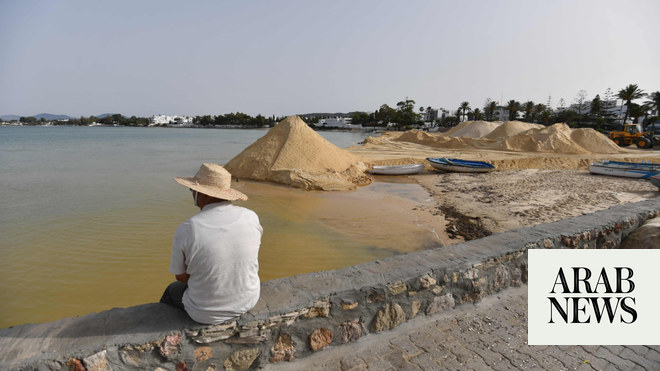HAMMAMET, TUNISIA: In the Tunisian seaside town of Hammamet, bulldozers are busily lifting sand from the desert near a popular beach to block it. will not be destroyed by destruction.
“This beach is the image of Hammamet,” said environmentalist Chiheb Ben Fredj looking nostalgically at the city's famous Yasmine beach.
“It's been ingrained in our minds since childhood,” he added, as workers worked to restore the central Tunisian coast to its former sandy glory.
Like many coastal areas in North Africa, overcrowding has led to many of Hammamet's sandy beaches disappearing in recent years, destroying the holiday hotspot around 65 kilometers (40 miles) east of the capital Tunis.
Coasts around the world are in constant flux, with seas demanding and depositing sediment.
But human activities, including coastal property development and offshore sand mining, are accelerating beach erosion.
Among other effects, the construction and protection of shorelines in an area can prevent sediment from moving along the shoreline, making existing beaches less accessible to new material.
Studies have also shown that the effects of climate change, including rising temperatures and sea levels, are increasing the incidence.
In the Mediterranean, where the British National Oceanography Center says sea levels have risen more in the past 20 years than in the entire 20th century, coastlines are changing rapidly.
The oceans are also warming 20 percent faster than the rest of the world, according to the United Nations.
Tunisia's coast is a major asset for the Mediterranean country with a struggling economy, as it aims to host around 10 million tourists this year.
Tourism accounts for up to 14 percent of the country's GDP, providing tens of thousands of jobs in a country where unemployment is 16 percent and 40 percent -hundreds of young people.
Tunisia has already lost more than 90 kilometers of beaches to erosion, according to official figures last year.
Of the 570 kilometers of sandy beaches suitable for swimming, 190 kilometers are at risk of disappearing, according to Tunisian reports.
Most of the beaches most affected by erosion are located near cities.
Environmental groups in Tunisia, as well as the government's Coastal Protection and Development Agency (APAL), blame the rapid climate change on human activities and construction on the coast. -tsiraka, which they say is only getting worse with climate change.
“The construction project is not designed to respect the movement of the coast,” an APAL official told AFP.
In order to save Hammamet beach, one of the most affected in Tunisia according to the World Bank, the authorities started last month with trucks of around 750 loads of sand. from the province of Kairouan in the desert, about 110 miles.
APAL, which works under the Ministry of Environment, was competing for time to fill the beach before the end of the tourist season.
But while repairing the beach, known as beach food, may be a quick fix, “it's not a long-term solution,” says Ben Fredj.
“This sand may not last long,” added the secretary general of the Environmental Education Association.
“It could be swallowed up in a few days if there's a storm,” he said, as it was in the summer of 2023.
The process can also be expensive.
The cost of restoring the sand on three beaches in Hammamet, Monastir and Sfax is estimated at 3.9 million Tunisian Dinars ($1.25 million).
But for local residents, restoring their precious coastline is worth the money.
Yasmine Beach is “the showpiece of Hammamet,” said Narjess Bouasker, who runs the city's Menara hotel and heads the regional hotel federation.
“We must restore the beaches that were swallowed by the sea,” he said, demanding a balance between protecting the environment, which residents and visitors love, and fighting coastal erosion.
“For us, the priority is not to touch the beauty of the city,” he said.
Bouasker said he has seen an increase in awareness among authorities, but filling beaches with sand is still a gamble.
“We don't know how the ocean will react,” he added.
